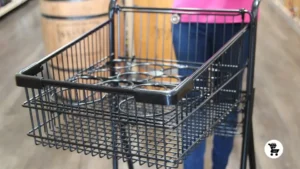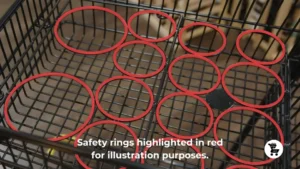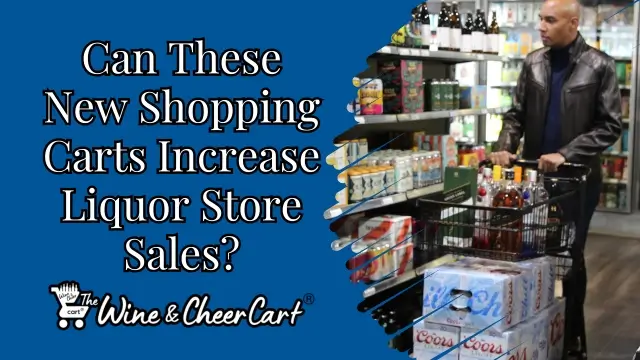The New Shopping Cart That Could Double Your Liquor Store Sales
In retail, the simplest innovations can have the most significant impacts. One such innovation transforming liquor stores across the United States is The Wine & Cheer Cart. Originally developed to eliminate breakage in stores, this specialized shopping cart has unexpectedly tapped into the psychology of consumer behavior, driving sales far beyond initial expectations.
Liquor stores that have replaced their standard carts with the Wine & Cheer Cart have experienced substantial increases in sales, with some reporting gains as high as 200%. But what is it about this shopping cart that makes it such a powerful tool for increasing revenue?
 The secret lies in its physical design and the psychological principles it taps into—principles that affect how we shop and make purchasing decisions. Our research and case studies suggest that The Wine & Cheer Cart is transforming liquor store sales by leveraging our natural tendencies toward symmetry, completion, and the desire to avoid leaving things unfinished.
The secret lies in its physical design and the psychological principles it taps into—principles that affect how we shop and make purchasing decisions. Our research and case studies suggest that The Wine & Cheer Cart is transforming liquor store sales by leveraging our natural tendencies toward symmetry, completion, and the desire to avoid leaving things unfinished.
The Original Purpose: Reducing Breakage
The Wine & Cheer Cart was initially created with a simple goal in mind: to prevent bottle breakage. Bottles of wine and liquor, especially in bulk purchases, are prone to tipping over in standard shopping carts, leading to costly breakages for the store and a frustrating experience for the customer. 
The solution? Safety rings embedded in the cart’s upper basket, designed to hold each bottle securely in place. The cart was an immediate success in terms of reducing bottle breakage, but what followed was an unexpected and fascinating side effect.
An Unintended Consequence: Boosting Liquor Sales Through Psychology
While the cart’s safety rings effectively prevented bottle breakage, they also introduced a subtle psychological nudge that many store owners weren’t anticipating. As customers filled their carts with bottles, they began to display a tendency to fill all of the safety rings, even when they had initially planned to purchase only a few items.
This unexpected behavior stemmed from key psychological principles that play a role in consumer decision-making: the desire for symmetry and the Zeigarnik Effect.
Tapping Into Symmetry: Why We Gravitate Toward Balance
Human beings are inherently drawn to symmetry. Numerous studies in psychology and cognitive science have shown that we prefer symmetrical patterns, both in nature and in the man-made objects we interact with. Our brains find symmetry easier to process, as it represents balance, order, and predictability. This is why a face or a piece of art that is perfectly symmetrical often seems more appealing or beautiful than one that is asymmetrical.
In the case of the Wine & Cheer Cart, the rings create a visual pattern of symmetry. Once a customer places a bottle in one ring, they have disrupted that symmetry. The empty rings stand out, creating an unconscious drive to restore the balance by filling more rings with additional bottles. It’s a subtle but powerful motivator: instead of buying one or two bottles, the customer is now more inclined to purchase three or four to complete the row, or even fill the entire cart.
For customers, this drive to achieve symmetry might not even register consciously, but it still affects their decision-making. Many psychologists believe this subconscious attraction toward symmetry is part of a broader desire for order and predictability in a chaotic world.
The Wine & Cheer Cart leverages this desire, subtly encouraging customers to add more bottles to their carts. This is how the subconscious need for symmetry may help liquor stores sell more when they offer The Wine & Cheer Cart to their customers.
The Zeigarnik Effect: The Need to Complete the Task
Another psychological principle at play is the Zeigarnik Effect. This effect, named after psychologist Bluma Zeigarnik, refers to our tendency to remember unfinished tasks more clearly than completed ones. When something is left incomplete, it creates a kind of cognitive tension that compels us to finish it.
The Zeigarnik Effect has applications in a wide range of contexts, from productivity and work habits to shopping behavior. In the context of the Wine & Cheer Cart, the safety rings act as an unfinished task. When customers place a few bottles into the rings, they have started something—but it’s not finished until all of the rings are filled.
This triggers the Zeigarnik Effect, prompting customers to complete the task by purchasing more bottles. The visual cue of the unfilled rings keeps the task of “filling the cart” active in their minds, making them more likely to buy additional items.
Liquor Stores Across the U.S. Are Seeing Results
Some of the top liquor stores across the country that have adopted the Wine & Cheer Cart are seeing significant results. Store owners have reported an increase in both the number of bottles purchased per customer and the overall sales volume. The cart’s ability to nudge customers toward buying more through its clever design has made it a valuable tool for increasing revenue.
What makes these results particularly impressive is that they come from a relatively simple change—switching out the store’s shopping carts. By aligning with natural human tendencies, the Wine & Cheer Cart helps stores maximize their sales without having to implement aggressive marketing strategies or discounts.
It’s a solution that seamlessly integrates into the shopping experience, making it more effective than traditional upselling techniques. It is important to note that these are specialized shopping carts for beverage alcohol retailers and they are only available through The Wine & Cheer Cart. It is not available through any of the other grocery cart manufacturers.
Why Symmetry and Completion Matter in Retail
The success of the Wine & Cheer Cart illustrates an important point about consumer behavior: small changes in the shopping experience can have a significant impact on sales. By understanding and applying psychological principles like symmetry and the Zeigarnik Effect, retailers can create environments that encourage customers to buy more without them feeling pressured or manipulated.
In the case of the Wine & Cheer Cart, the cart itself becomes a tool for driving wine and liquor sales, simply by aligning with the natural cognitive processes that influence our decision-making. The result is a win-win: customers enjoy a safer and more convenient shopping experience, while stores benefit from increased sales and customer satisfaction.
Beyond Liquor Stores: The Versatility of the Wine & Cheer Cart
While the Wine & Cheer Cart was designed with the intention of being the best liquor store shopping cart in the industry, its benefits extend beyond just wine and spirits. The cart can easily be adapted for use in grocery stores, holding a wide variety of bottles and containers, including juices, oils, vinegars, dressings, and jarred items. Its ability to securely hold different types of products makes it a versatile solution for any retail environment where bottles are a primary product category.
Ready to See How the Wine & Cheer Cart Can Boost Your Sales?
If you’re a wine or liquor store owner looking to increase sales and improve the shopping experience for your customers, it’s time to consider the Wine & Cheer Cart. With its patented design and proven ability to potentially boost sales, this cart is more than just a tool for preventing bottle breakage—it’s a sales driver that leverages key psychological principles to encourage customers to buy more.
Interested in learning more? Contact us today for case studies, product information, and testimonials from liquor stores that have seen their sales soar after implementing the Wine & Cheer Cart. Visit us at wineandcheercart.com to discover how this innovative cart can transform your business.
And “Cheers to more sales!”
DISCLAIMER: While the Wine & Cheer Cart is designed based on established retail and psychological principles, individual results may vary. The effectiveness of the Wine & Cheer Cart in increasing sales depends on numerous factors beyond our control, including but not limited to store layout, product selection, pricing, customer demographics, and overall market conditions. We do not guarantee any specific increase in sales or revenue as a result of using the Wine & Cheer Cart.
By purchasing or using the Wine & Cheer Cart, you acknowledge that you are solely responsible for your business outcomes. We expressly disclaim any warranties or representations regarding the performance of the Wine & Cheer Cart in increasing sales. Our company shall not be held liable for any direct, indirect, incidental, consequential, or special damages arising out of or in any way connected with the use of the Wine & Cheer Cart or the inability to achieve desired sales results.
It is the responsibility of each business to evaluate the suitability of the Wine & Cheer Cart for their specific needs and to implement it as part of a comprehensive retail strategy. We recommend consulting with a retail specialist to maximize the potential benefits of the Wine & Cheer Cart in your unique business environment.

